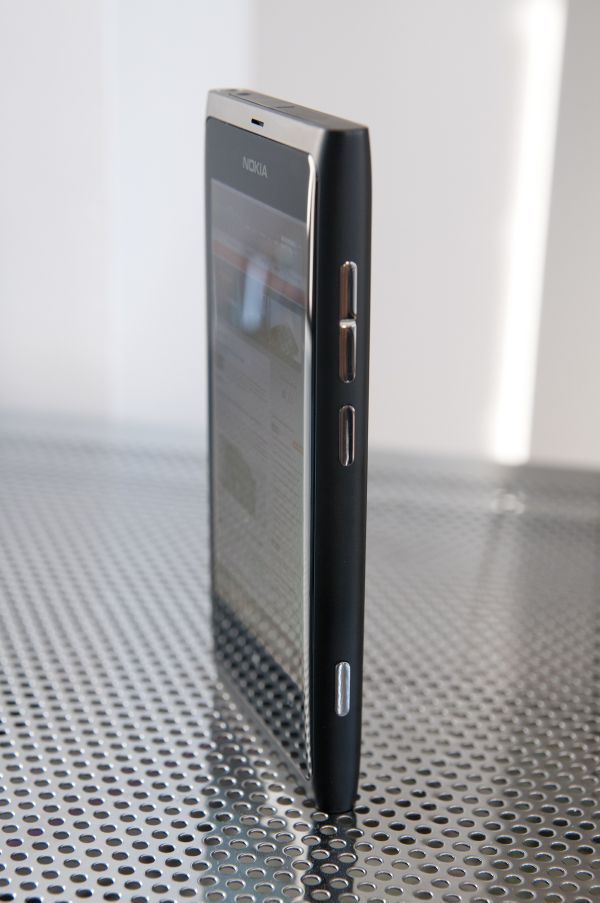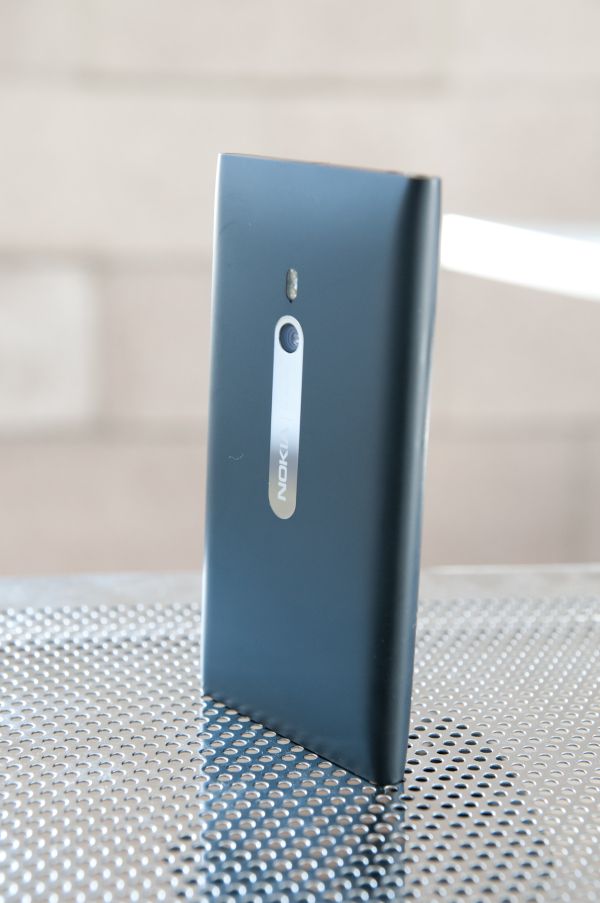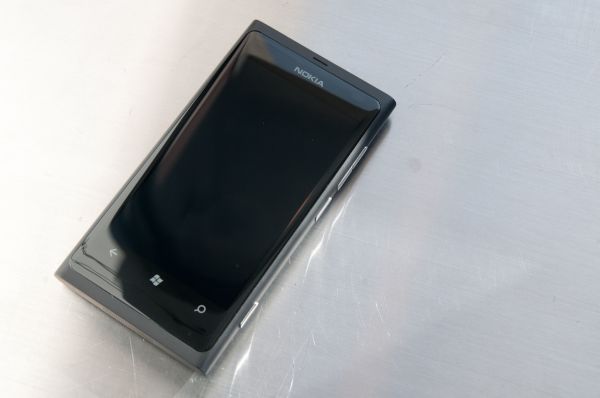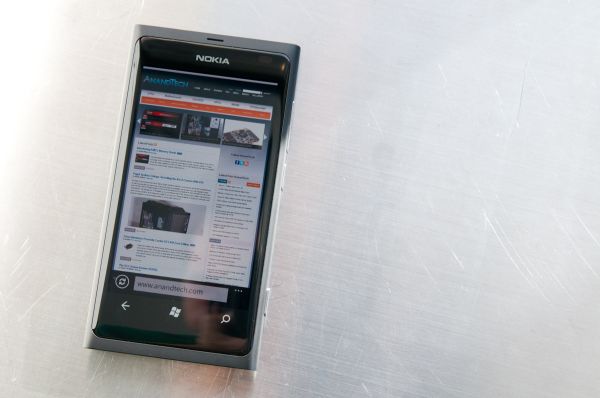Nokia Lumia 800 Review - Nokia's Brave New Foray into WP7
by Brian Klug on January 4, 2012 7:00 AM EST- Posted in
- Smartphones
- Nokia
- windows phone 7
- Mobile
- WP7
- Lumia
- Lumia 800
Conclusions
The Lumia 800 is indubitably the best Windows Phone hardware out there right now. When people previously spoke in hushed tones about wanting Nokia to make Windows Phones, the unspoken reasons for wanting a Nokia WP7 device were a few notable features - a camera without compromises, hardware build quality that’s unique and solid, Nokia’s attention to detail, and Nokia's existing market share and ability to get those devices to market.
The Lumia 800 is unique in that it’s the first step in Nokia’s switch to Windows Phone, and for the large part does fulfill a big cross section of those criteria, at least at the high end. I can’t shake the feeling, however, that many people simply wanted a Nokia N8 running Windows Phone 7 (and its still-unsurpassed camera quality). For whatever reason, however, the platform Nokia chose to go with that would become the Lumia 800 borrowed the N9’s exterior instead.
I have nothing but praise for the physical build quality of the Lumia 800, and it's really that attention to detail which puts the Lumia 800 squarely in the lead, at least in my mind. The competition has similar or identical specifications on paper as well (the same 1.4 GHz MSM8x55 SoC, 8 MP camera, 512 MB of RAM, etc.), so it's in these ancillary features that Windows Phone hardware differentiates itself from the pack.
The Lumia 800 does have a few places where it stumbles, however. The aforementioned charging and battery situation is a notable issue that represents a considerable oversight, and I find myself wishing that, like so many other Nokia devices, the phone shipped with pentaband WCDMA instead of two tri-band variants. Having an internal battery is another point of contention, though it’s hard to judge how good battery life will be after Nokia has patched the power management IC firmware.
There’s also the Windows Phone side of things, where Nokia diehards haven’t pulled any punches taking note of the platform’s shortcomings - lack of USB or external storage, a still fledgling application ecosystem, and a few others. I’m inclined to agree that while the other major smartphone OSes have taken some big steps forwards, WP7.5 only now just arrives at parity with where those OSes were midway through last year. There’s still time for WP7.5 to catch up, but I can’t shake the feeling that despite the OS being so much better than it was when it launched, it still isn’t as powerful as the alternatives. For normal consumers the functionality WP7.5 offers is perfect, but for Symbian and Maemo users looking at the Lumia series it’s a huge deal. On the other hand, Nokia's WP7.5 devices do include Nokia's suite of software, which importantly includes turn by turn GPS navigation (Nokia Drive) for free, where the other WP7 contenders would have you use TeleNav GPS or another subscription service.
While it's unclear in what form or on what carrier the Lumia 800 will arrive stateside, it's clear that something superficially similar to the Lumia 800 is in store for AT&T at least. Among the rest of the Windows Phone contenders, it's arguably neck and neck between the Samsung Focus S and the Lumia 800, but how fast Nokia can fix those charging issues might tip the scales. How the Lumia series does against Windows Phones from Samsung, HTC, and LG remains to be seen, but if the Lumia 800 is any indication of what's in store, I think they're in for some competition.














120 Comments
View All Comments
Iketh - Wednesday, January 4, 2012 - link
You can't watch youtube videos without the app on WP. If you try, the website instructs you to download the youtube app first. You can browse youtube all you want, just can't play the videos. The way the site words this almost makes it sound like it's youtube's fault, but I wouldn't know.melgross - Wednesday, January 4, 2012 - link
So, this is a fairly mediocre phone as far as performance goes, but the reviewer really wants to believe it to be better than it is.It's pretty obvious that WP7+ needs a dual core SoC, with a much better GPU. When that happens, we'll see a phone that can properly compare to the other top phones on other OS's, such as Android and iOS. Until then, no excuses can fix the slow nature of this model. If this were a cheaper, lower end model, it might be worthwhile, but for the flagship model, it's simply not worth it.
And then, AMOLED isn't really ready for prime time. Despite the propaganda from the manufacturers who use them, I've not yet seen a review of an AMOLED device that was more than about half as bright as a good LCD model, and often no better than a third as bright. This one seems poor. To say that it seems brighter than it can possibly be, is nonsense.
I hope that we will see much better phones than this one during the year, and soon. If not, it will be another reason why WP7 will struggle.
Brian Klug - Wednesday, January 4, 2012 - link
I'd agree with that assertion - WP7 does need to make the move to dual core, (and will make the move to dual core) if nothing else to get all the other features that come with it. I touched on this a little, but better encoders, better decoders, and on the QCT side better baseband all come on the high-end before eventually showing up on the midrange.The other curious thing is that AMOLED can actually go way brighter (with some of Supercurio's hacks, you can drive the SGS2 SAMOLED Plus display up past 500 nits) but you end up just burning through battery. Obviously there's still some balancing being done by OEMs to keep battery from being totally depleted.
-Brian
melgross - Wednesday, January 4, 2012 - link
There are several very good reasons why AMOLEDs aren't bright. LED's of all kinds, but especially OLED'S, are very constrained by temperature. The higher they are driven, the hotter they get. The hotter they get, the shorter the life. Driving an AMOLED screen to the brightness of the 4S, for example, would bring the lifetime down to less than a quarter of what it is now.In addition, this isn't a linear relationship. More voltage results in less than a 1:1 relationship in brightness, and an even worse relationship when looking at current draw. There's a good reason why UI's designed for AMOLED's use a great deal of black with thin lettering. On average, right now, even the best AMOLEDs use more current than do most LCDs with high efficiency LED backlighting. I find it amusing when I read that AMOLEDs use less energy, when they use more.
I have a lot of LED's here, up to 200 watts (for a single LED). I've yet to find one that lives up to its promise, though they're getting better. I would give AMOLED's at least another two years, and with IGZO displays coming out, possibly another four years until they equal the efficiency.
Color quality, which is poor, is another question altogether.
french toast - Thursday, January 5, 2012 - link
AMOLEDs typically dont come half as bright as the brightest lcds, hell the nokia 701 gets over 1000nits brightness!! so thats 5 times brighter than this model.However brightness tests like this rarely carry through to real life,especially when talking about AMOLEDS, they have the best contrast ratio as well as saturated colours which make the screen pop, you never read a review about an AMOLED phone and get complaints about it being dull..quite the contrary the AMOLED always seems to be brighter..
If brian hadnt ran that test, he wouldnt have mentioned that the screen seems dull.
Some of the appeal of AMOLEDS is that over saturated colour profile, which seems to be a marmite issue, half the people prefer IPS LCD and half swear by a decent RGB AMOLED.
AMOLEDS have many advantages over LCD though, they are thinner, much much better contrast, far far superior response time, more eye popping colours and better power levels when watching dark seens like movies...The sunlight issue which was the worse complaint has disapeared.
One of the biggest complaints about AMOLED compared to a high quality LCD is color accuracy..BUT although this is a bug for some,
most people PREFER the saturated colors, indeed when i read reviews on you tube of people comparing the most accurate hd phone display yet..the IH-IPS display on the LG Nitro the reviewers said they much prefered the nexus display, and that somehow it gave the impression of being BRIGHTER..despite what these tests say.
Spivonious - Wednesday, January 4, 2012 - link
Slow nature of this model? I have one of the launch WP7 phones (LG Quantum), and experience no slowness. The fact is that MS has optimized the OS to perform on a single-core CPU. The phone OEMs are free to add an improved GPU, but there's no need for it. Javascript benchmarks are meaningless to me. Who browses the web for any amount of time on a 4" screen?melgross - Wednesday, January 4, 2012 - link
Just read the tests. It's all there. Sometimes something doesn't feel as slow, or as fast as it is, but the numbers don't lie.465thGTG - Wednesday, January 4, 2012 - link
I'll take real world feel over benchmark numbers any day. My Titan feels faster and more fluid than my Galaxy S II. What else is there to say?doubledeej - Thursday, January 5, 2012 - link
If someone spent all day every day running Javascript, I might agree with you. But so little of the time spent using the phone is spent doing that. Everything else about the phone feels much faster than ANY Android model, regardless of CPU speed or number of cores. Having everything be GPU accelerated makes a world of difference in how fast it feels.You just never wait for anything other than your data connection on these phones.
doobydoo - Saturday, January 7, 2012 - link
I've never tried the Titan, but your reasoning is exactly why the iPhone 4S feels faster than the Galaxy S2 too - the GPU hardware acceleration.That and the fact it has the fastest CPU/GPU combination of any phone ever made.